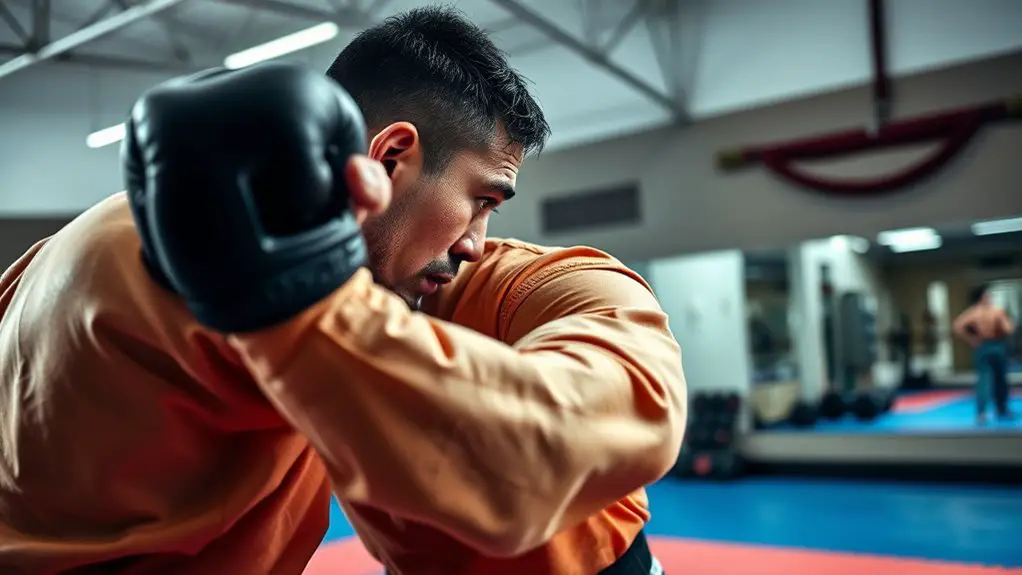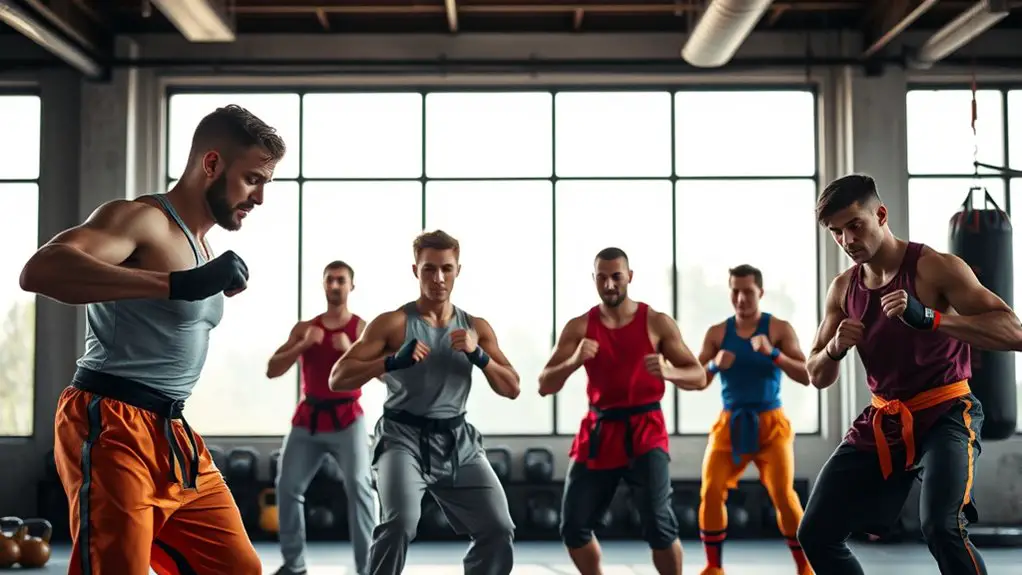How to Build Endurance for Martial Arts With Gym Training

To build endurance for martial arts with gym training, focus on a mix of strength training, HIIT, and flexibility exercises. Include compound lifts like squats and deadlifts to enhance muscle endurance and stability. Add high-intensity intervals, like sprints or circuit training, to boost cardiovascular fitness. Don’t forget nutrition—fuel your workouts with carbohydrates and lean proteins, and stay hydrated. This balanced approach maximizes your performance and prepares you for the demands of martial arts. There’s more to discover!
Understanding Endurance in Martial Arts

Endurance is the backbone of martial arts, enabling you to push through intense training and competitions. To build that endurance, you’ll need to focus on specific endurance techniques. These might include interval training, which alternates high-intensity bursts with recovery periods, helping to improve both aerobic and anaerobic capacity.
However, there are some endurance misconceptions to be aware of. Many believe that simply running long distances will enhance their stamina, but in martial arts, you need to simulate the explosive movements and energy demands of your sport. Incorporating drills that mimic fight conditions—like sparring or pad work—will better prepare you for the real thing.
Importance of Strength Training for Endurance
While many focus solely on cardiovascular workouts to boost endurance, incorporating strength training is equally essential. Strength training benefits your martial arts performance by building muscle, improving stability, and enhancing overall power. When you combine endurance training techniques with strength workouts, you create a strong foundation that helps you last longer in the ring. Skipping rope is a powerful exercise that can also be integrated into your training routine for improved endurance and cardiovascular health.
Here’s a quick overview of the benefits:
| Strength Training Benefits | Endurance Impact | Example Technique |
|---|---|---|
| Increased Muscle Mass | Improved stamina | Compound lifts |
| Enhanced Core Stability | Better balance | Planks and variations |
| Boosted Metabolism | Faster recovery | High-intensity circuits |
| Injury Prevention | Long-term endurance | Resistance bands |
Key Exercises to Boost Cardiovascular Endurance

To excel in martial arts, you can’t overlook the importance of cardiovascular endurance. Building your aerobic capacity through targeted endurance workouts will enhance your performance on the mat. Here are four key exercises to elevate your endurance:
- Running or Jogging: Consistent running improves your heart rate and stamina. Aim for distance or time-based goals.
- Cycling: Whether on a stationary bike or outdoors, cycling can effectively boost your aerobic capacity while being low-impact.
- Jump Rope: This simple exercise is fantastic for building endurance and coordination. Try interval training with different speeds. It can be classified as both aerobic and anaerobic, depending on the intensity and duration of your jumps.
- Swimming: Swimming engages multiple muscle groups and is excellent for overall cardiovascular conditioning.
Incorporate these exercises into your routine, and you’ll notice significant improvements in your endurance. Remember, the more you push your limits, the stronger you’ll become in martial arts!
Incorporating High-Intensity Interval Training (HIIT)
Incorporating High-Intensity Interval Training (HIIT) into your routine can greatly elevate your martial arts performance. HIIT benefits include improved cardiovascular endurance and increased stamina, vital for those intense sparring sessions. Start with a HIIT schedule that balances work and rest; a popular technique is 30 seconds of high-intensity effort followed by 30 seconds of recovery.
Explore HIIT variations like sprints, kettlebell swings, or bodyweight exercises to keep your workouts fresh. As you progress, increase the intensity or duration of your intervals for better HIIT progression. Additionally, consider incorporating skipping rope workouts into your training, as they can enhance coordination and balance.
Stay motivated by tracking your performance and setting achievable goals. Remember, HIIT safety is important—always warm up adequately and listen to your body during recovery. By incorporating HIIT techniques into your training, you’ll build the endurance needed to excel in martial arts and release your full potential.
Building Muscular Endurance With Resistance Training

After working on your cardiovascular endurance with HIIT, it’s time to focus on building muscular endurance through resistance training. By enhancing your muscular endurance, you’ll be better equipped to handle prolonged activities in martial arts, minimizing muscle fatigue. Here are four key strategies to help you develop resistance adaptations:
- High Reps, Low Weights: Aim for 12-20 reps per set to target endurance rather than strength.
- Circuit Training: Combine multiple exercises with minimal rest to keep your heart rate up while building endurance.
- Compound Movements: Include exercises like squats and push-ups that engage multiple muscle groups, promoting overall endurance.
- Progressive Overload: Gradually increase the weight or repetitions over time to challenge your muscles and encourage adaptations.
Incorporating these techniques will guarantee your body adapts effectively, preparing you for the demands of martial arts. Additionally, consider integrating jump rope workouts to improve your cardiovascular fitness and overall endurance.
The Role of Flexibility and Mobility in Endurance
Flexibility and mobility are essential for enhancing your endurance in martial arts. Incorporating both dynamic and static stretching into your routine not only improves your range of motion but also helps prevent injuries. By prioritizing these elements, you’ll be better equipped to perform at your best when it counts.
Importance of Stretching
Stretching isn’t just an afterthought; it’s an essential component of building endurance in martial arts. Incorporating both dynamic and static stretching into your routine can greatly enhance your performance and prevent injuries. Here are four key benefits of stretching:
- Improved Flexibility: Increases your range of motion, allowing for more efficient movements during training and sparring.
- Enhanced Blood Flow: Promotes circulation, delivering oxygen and nutrients to your muscles, which aids in recovery.
- Injury Prevention: Reduces muscle tightness, minimizing the risk of strains and sprains.
- Better Performance: Increases your overall endurance, helping you last longer in intense training sessions and competitions.
Make stretching a priority, and you’ll notice the difference in your martial arts journey!
Dynamic vs. Static Mobility
While you might think of flexibility as a single concept, understanding the difference between dynamic and static mobility is key to enhancing your endurance in martial arts. Dynamic stretching involves moving parts of your body through a range of motion, preparing your muscles for action. Incorporating dynamic stretching into your warm-up can boost your agility and power, essential for high-intensity training. On the other hand, static stretching focuses on lengthening muscles while holding a position, improving overall flexibility. It’s best used post-training to aid recovery. Balancing both types of stretching will not only increase your flexibility but also enhance your endurance, allowing you to perform better in martial arts. So, embrace both and watch your performance soar!
Nutrition Tips to Support Endurance Training

To maximize your endurance training in martial arts, it’s essential to fuel your body with the right nutrients. Here are some key nutrition tips to support your efforts:
Maximize your martial arts endurance by fueling your body with the right nutrients for optimal performance.
- Prioritize Carbohydrates: They’re your body’s primary energy source. Opt for whole grains, fruits, and vegetables to keep your energy levels high.
- Focus on Protein: Incorporate lean proteins like chicken, fish, or legumes to aid muscle recovery and growth.
- Hydration Strategies: Stay hydrated before, during, and after workouts. Water is essential, but consider electrolyte drinks for intense sessions.
- Meal Timing: Eating a balanced meal 2-3 hours before training helps optimize performance. A post-workout meal within 30 minutes is critical for recovery.
Creating a Balanced Workout Plan
To build endurance in martial arts, you need a balanced workout plan that includes strength training, cardiovascular conditioning, and flexibility work. Each component plays an essential role in enhancing your performance and preventing injuries. By integrating these elements, you’ll maximize your training and boost your overall endurance. Incorporating jump rope into your routine can significantly improve your cardiovascular fitness and coordination, further aiding your martial arts performance.
Strength Training Exercises
Incorporating strength training exercises into your martial arts routine is essential for building endurance and enhancing overall performance. Focus on a balanced approach that includes both bodyweight exercises and compound movements. Here are four effective exercises to get you started:
- Push-ups: Great for upper body strength and core stability.
- Squats: A fundamental move that builds leg strength and power.
- Deadlifts: Perfect for developing your posterior chain, improving lifting techniques.
- Pull-ups: Excellent for upper body and grip strength, crucial for grappling.
Cardiovascular Conditioning Routines
While strength training builds a solid foundation, effective cardiovascular conditioning is essential for enhancing your endurance in martial arts. Incorporating aerobic exercises into your routine can greatly improve your stamina. Consider blending circuit training with traditional cardio to maximize results. Here’s a simple plan to get you started:
| Workout Type | Duration |
|---|---|
| Aerobic Exercise | 20 minutes |
| Circuit Training | 30 minutes |
| Recovery/Stretching | 10 minutes |
Flexibility and Mobility Work
Although many focus on strength and endurance, neglecting flexibility and mobility can hinder your martial arts progress. Incorporating flexibility and mobility work into your training routine is essential for peak performance. Here are four key components to evaluate:
- Dynamic Stretching: Warm up with movements that mimic martial arts techniques to enhance blood flow and prepare your muscles.
- Mobility Drills: Focus on joint mobility to improve your range of motion and reduce injury risk.
- Flexibility Routines: Implement targeted stretches post-workout to enhance flexibility and aid recovery.
- Recovery Techniques: Use foam rolling and yoga to facilitate muscle recovery and maintain flexibility.
Monitoring Progress and Adjusting Your Training
How can you effectively track your progress and optimize your training for martial arts endurance? Start by keeping a detailed workout journal. Document your exercises, durations, and intensity levels to visualize your improvements over time. This progress tracking not only highlights your gains but also helps identify areas needing attention.
Next, assess your performance regularly. Set specific endurance benchmarks, like the number of rounds you can spar or the distance you can run. When you notice stagnation, it’s time for training adjustments. Incorporate variety into your workouts, such as interval training or circuit routines, to keep your body challenged and engaged.
Lastly, listen to your body. If you’re feeling fatigued or plateauing, consider adjusting your rest days or modifying your workout intensity. By actively monitoring your progress and making necessary adjustments, you’ll build the endurance you need for martial arts success. Keep pushing forward! Additionally, be aware of signs of progress that indicate your training is effective and leading to improvements in your endurance.
Mental Strategies for Enhancing Endurance

To enhance your endurance in martial arts, it’s essential to develop strong mental strategies alongside your physical training. Here are four effective methods to boost your mental resilience:
Enhancing endurance in martial arts requires a focus on mental strategies as much as physical training.
- Visualization Techniques: Picture yourself successfully completing challenging workouts or sparring sessions. This mental rehearsal can build confidence and prepare you for the real thing.
- Set Achievable Goals: Break down your endurance training into smaller, manageable milestones. Celebrating these wins keeps you motivated and focused.
- Positive Self-Talk: Replace negative thoughts with affirmations. Remind yourself of your capabilities and progress, especially during tough moments.
- Mindfulness and Breathing: Incorporate mindfulness practices to stay present during training. Deep breathing can help manage stress and maintain your composure when fatigue sets in.
Frequently Asked Questions
How Long Should I Train Each Week for Optimal Endurance?
To achieve ideal endurance, you should aim for a training frequency of 4 to 6 sessions per week. Each session should last between 60 to 90 minutes, focusing on both aerobic and anaerobic exercises. Consistency is key, so don’t skip workouts! Incorporate varied intensities and techniques to challenge yourself. You’ll see improvements in your stamina and overall performance, making it easier to push through those tough martial arts sessions. Stay committed!
Can I Build Endurance Without Using Weights?
Absolutely, you can build endurance without using weights! Think of it like training for a marathon; it’s all about consistency. Incorporate bodyweight exercises like push-ups, squats, and lunges into your routine. Combine these with aerobic conditioning, such as running, cycling, or swimming. This blend will not only boost your stamina but also enhance your overall fitness. So, get moving, and remember: endurance is built one step at a time!
What Role Does Rest Play in Endurance Training?
Rest plays an essential role in endurance training. Without proper rest, your body can’t recover, which is important for building endurance. You’ll find that rest advantages include reducing the risk of injury, improving performance, and boosting overall results. Recovery’s significance can’t be overstated; it allows your muscles to repair and grow stronger. So, don’t underestimate the power of rest—embrace it as a critical part of your training journey!
Should I Adjust My Training for Different Martial Arts Styles?
Oh sure, just train the same for every martial art! Who needs style-specific adaptations when you can be a one-size-fits-all fighter? But seriously, you should absolutely adjust your training for different martial arts styles. Each discipline has unique demands, so embrace those training variations. Whether it’s striking, grappling, or weaponry, tailor your endurance workouts to enhance your skills and performance. It’s not just smart; it’s essential for growth and success!
How Do I Prevent Injuries While Training for Endurance?
To prevent injuries while training for endurance, focus on proper training techniques. Start with a solid warm-up to prepare your muscles and joints. Gradually increase your intensity and duration to avoid overexertion. Incorporate rest days and listen to your body; if something hurts, don’t push through it. Strength training can also help support your endurance work. Stay hydrated and maintain flexibility to enhance recovery and reduce the risk of injury.





